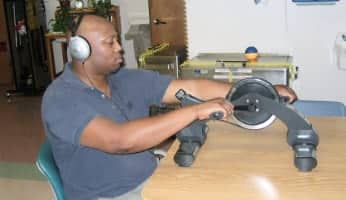Dawn’s Brighter Days: Navigating Parkinson’s with Interactive Metronome

Home - Testimonials - Adult Testimonials - Dawn’s Brighter Days: Navigating Parkinson’s with Interactive Metronome

Dawn’s Brighter Days: Navigating Parkinson’s with Interactive Metronome
Dawn is a 65 year-old woman who was diagnosed with Parkinson’s disease ten years ago.
She is currently prescribed several medications to control symptoms. Dawn also exercises regularly, which helps some with gross motor control, strength and endurance.
Interactive Metronome Training Approach
Her therapist thought IM training could help with motor control and balance. Dawn’s LFA scores varied (between 43-164 ms), with most of the high scores coming on lower body tasks. IM sessions were scheduled for once a week, and goals included increased energy, greater flexibility and more balance when walking.
Adjustments for Parkinson’s Symptoms
Some adjustments had to be made because of her Parkinson’s symptoms. While the standard tempo of 54 was suitable for her upper body, a tempo of 50 was needed for her lower body.
She also occasionally needed to vary the tempo, depending on how she was feeling physically that day.
Regardless of the setting, she always used the same tempo setting for BOTH upper and lower body.
Additionally, hand exercises were done seated and all exercises were brief–upper body typically 3.5 minutes and lower body 1.5-2 minutes.
When her legs would tire, she simply alternated between hand and foot exercises (sitting and standing).
Standing exercises were sometimes done with a chair at her side so she could keep herself steady.
Progress and enhanced Quality of Life
Dawn said that she noticed a burst of energy after the initial assessment. She would also experience 5-6 hours of energy on training days, or within three days of her IM sessions.
She mentioned her medications felt “on” more often, and she felt more agile and confident walking up and down stairs.
Her improved balance and flexibility allowed her to get more done around the house, and best of all, Dawn was able to play the piano again.
Toward the end of the program she was able to work in two sessions per week instead of only one. That helped Dawn feel good for two days at a time instead of only 5-6 hours.
Conclusion and Continuing Care
Post LFA scores showed incredible improvement (between 27-57 ms). Dawn completed 16 IM sessions and decided to purchase the IM-Home unit for maintenance.
She still comes in for traditional IM sessions when she feels it is needed, but those are few and far between.
Dawn credits IM training with increasing her energy level and stamina, and she says it is helping her to stay ahead of her Parkinson’s!
Presented by Karen Farron, OTR/L, MHS, MIMC of Kansas Rehabilation Hospital






